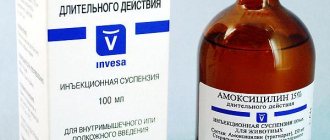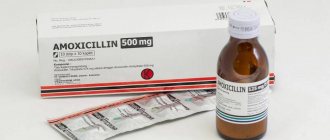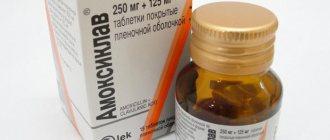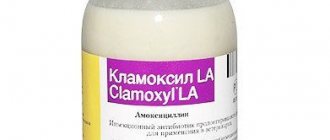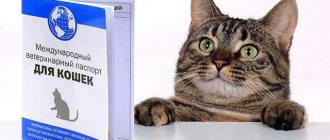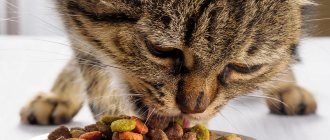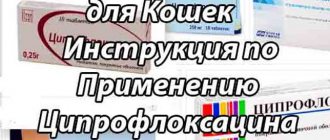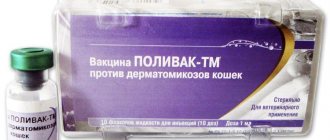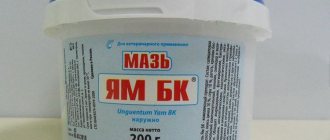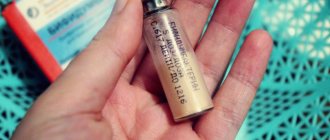Amoxoil retard
AMOXOIL RETARD
COMPOSITION AND FORM OF RELEASE
A long-acting antibacterial drug containing 150 mg of amoxicillin trihydrate and filler per 1 ml as an active ingredient. Produced in the form of a sterile suspension for injection, white in 100 ml dark glass bottles, which are placed in cardboard boxes.
PHARMACOLOGICAL PROPERTIES
Amoxicillin is a semisynthetic antibiotic from the penicillin group. It has a wide spectrum of bactericidal action against gram-positive (staphylococci, streptococci, clostridia, listeria, corynebacteria, actinomycetes) and gram-negative (bordetella, escherichia, fusobacteria, salmonella, pasteurella, hemophilus, proteus, moraxella) microorganisms, as well as leptospira. Amoxicillin interferes with the synthesis of the bacterial cell wall, inhibiting the enzymes transpeptidase and carboxypeptidase and causing an imbalance in the osmotic balance, which leads to the death of the bacterium during the growth stage. When administered parenterally, amoxicillin is well absorbed into the blood from the injection site and is quickly distributed in the body. The maximum concentration in blood plasma is achieved 1-2 hours after administration of the drug and remains at a therapeutic level for 48-72 hours. Amoxicillin is practically not metabolized. It is excreted from the body mainly in urine, and to a lesser extent in milk and bile.
INDICATIONS
Prescribed to cattle, sheep, pigs, dogs and cats for the treatment of pneumonia and other respiratory diseases, enteritis and gastroenteritis, inflammation of the genitourinary organs, atrophic rhinitis, leptospirosis and other diseases caused by microorganisms sensitive to amoxicillin.
DOSES AND METHOD OF APPLICATION
Amoxoil retard is administered to animals intramuscularly or subcutaneously at a dose of 1 ml per 10 kg of animal weight. If necessary, the drug can be re-administered after 48 hours. For animals with renal failure, it is recommended to accurately adjust the dose of the drug. Before use, shake the contents of the bottle thoroughly until a homogeneous suspension is obtained. To administer the Amoxoil retard suspension, use only dry, sterile syringes and needles. If the administered dose of the drug exceeds 20 ml, it is recommended to administer it in several injections at different points. It is recommended to lightly massage the injection site after administering Amoxoil retard.
SIDE EFFECTS
Animals may have allergic reactions to amoxicillin, which quickly subside after discontinuation of the drug. Intoxication due to overdose is almost impossible. If allergic reactions occur, it is advisable to administer corticosteroids and adrenaline to animals.
CONTRAINDICATIONS
Hypersensitivity to amoxicillin and other penicillins. Do not administer intravenously. Not allowed for use on rabbits, hamsters, guinea pigs and gerbils. Amoxicillin should not be mixed with other drugs in the same syringe, and should not be used simultaneously with bacteriostatic chemotherapeutic agents. The drug should not be prescribed for infections caused by bacteria that produce penicillinase.
SPECIAL INSTRUCTIONS
Slaughter of animals for meat is permitted 14 days after cessation of drug administration. The meat of animals forcedly killed before the expiration of the specified period can be used to feed fur-bearing animals or to produce meat and bone meal. Milk from animals that were administered Amoxoil retard suspension can be used for food purposes 48 hours after the end of treatment. Milk obtained from animals during the period of amoxicillin use and until 48 hours after the last administration of the drug is used for feeding animals.
STORAGE CONDITIONS
With caution (list B). In a dry place, protected from light and out of reach of children, at a temperature of 5 to 20 ° C. Shelf life: 3 years.
Side effects of amoxicillin in cats
Although most cats do not suffer any side effects, and if they do occur, they are usually not serious. However, this must be taken into account.
Side effects of amoxicillin in cats:
- Hypersensitivity. There have been cases where allergic reactions to amoxicillin have occurred, so if you know your cat is allergic, you will not be given this antibiotic. If you encounter such an allergy, you should contact your veterinarian as soon as it is discovered.
- Gastrointestinal problems may occur, leading to vomiting and diarrhea. If this occurs, it is best to administer amoxicillin with food, which can reduce these symptoms.
- In very rare cases, cases of neurotoxicity have been observed, which occurs with very high doses or with long-term use of amoxicillin.
- Although this antibiotic is not toxic to the liver, high levels of liver enzymes have been observed after amoxicillin use.
- Difficulty breathing and rapid heartbeat (very rare).
Now that you are very knowledgeable about this antibiotic, remember to always visit your veterinarian if you notice any symptoms that your cat may be sick, and remember not to take the medication yourself.
Amoxicillin is prescribed to cats for the following diseases:
- gastroenteritis, diarrhea, salmonellosis;
- bronchitis, rhinitis;
- vaginitis, cystitis;
- injuries;
- joint inflammation;
- diseases of soft tissues and skin.
Amoxicillin is prohibited for cats with hypersensitivity to beta-lactam antibiotics. This remedy should not be used for liver problems, because hepatitis may develop. The solution must not be mixed with other drugs.
Side effects
According to the instructions for use, the following side effects are possible:
- Allergic reactions. Even those animals that have never suffered from allergies may react ambiguously to the use of Amoxicillin. Therefore, after the animal has received the medicine for the first time, you need to monitor its condition. If any signs of unwellness appear, you should immediately consult a doctor.
- The skin where the injection was given may turn slightly red. In more severe cases, dermatitis may develop.
- With prolonged use of the product without obvious need, Quincke's edema may occur.
- After taking the drug, vomiting and diarrhea may begin.
If any of the above side effects occur, you should immediately stop taking the medication. Continued use of Amoxicillin can cause anaphylactic shock in the animal. This condition often ends in death.
Amoxoil Dose for Dogs and Other Animal Species
- 1 kg – 0.1 ml, subcutaneously or intramuscularly, if necessary, repeat the injection after 48 hours
- 5 kg – 0.5 ml
- 10 kg – 1 ml, subcutaneously or intramuscularly, if necessary, repeat the injection after 48 hours
- 15 kg – 1.5 ml
- 20 kg – 2.0 ml
- 30 kg – 3.0 ml
- 40 kg – 4.0 ml
- 50 kg – 5.0 ml
- 100 kg – 10.0 ml
- 200 kg – 20.0 ml
- 300 kg – 30 ml
- 400 kg – 40 ml
- 500 kg – 50 ml
Animals should not be injected with more than 20 ml of the drug in one place.
Amoxoil for dogs and other species of animals (in Latin - Amoxoil retard)
According to the instructions for use, amoxoil interferes with the synthesis of the bacterial cell wall
, pathogens of infections in animals, inhibiting the enzymes transpeptidase and carboxypeptidase and causing an imbalance in the osmotic balance, which leads to the death of the bacterium during the growth stage. When administered parenterally in dogs, amoxoil is well absorbed into the blood from the injection site and is quickly distributed in the body. The maximum concentration in the blood plasma of dogs is achieved 1-2 hours after administration of the drug and remains at a therapeutic level for 48-72 hours. Amoxoil is practically not metabolized in the body of dogs and other animal species. It is excreted from the body mainly in urine, and slightly - in milk and bile.
What does amoxicillin help for cats?
This antibiotic does a lot; it actively fights the following parasites:
- coli;
- staphylococcus;
- streptococcus;
- and other bacteria.
Veterinarians prescribe it for infectious diseases and inflammations, as well as in cases of complications of these ailments.
It plays an important role in treatment so that the pathogen is as sensitive as possible to this medicine. Therefore, it is very important to visit a veterinarian before your appointment.
If he prescribes this drug, he must decide on the dosage. And then tell the owner what it should be like.
The instructions for use contain all the important points that the owner must familiarize himself with, especially if he forgets what the veterinarian said.
READ How to trim a cat's claws if she's struggling
How is this medicine used in veterinary medicine and to treat dogs?
Amoxoil is believed to have a fairly broad spectrum of action against many bacteria
, it is also a good choice when the sensitivity of the bacteria is unknown. This is especially useful for anaerobic infections (those that grow without oxygen). Typical uses may include:
- Infected bite wounds in dogs
- Upper respiratory tract infections in animals
- Tooth and gum infections in dogs
- Bladder infections in animals
- Staphylococcal infections in dogs
Amoxoil Retard: drug review
When the first clinical symptoms appear in cats and other pets, in order to avoid the development of serious complications, it is very important to immediately contact a veterinary clinic, where, after diagnosis, the veterinarian will select adequate effective treatment. Do not forget that many bacterial and viral diseases can cause the death of furry pets. As a rule, to treat infections of various etiologies, cats are prescribed antibacterial drugs. For example, Amoxoil retard.
Amoxicillin analogues
Efficiency, safety and relatively low price make Amoxicillin a very popular and sought-after drug. The cost of a package of Amoxicillin tablets does not exceed one hundred rubles; the price of a 10-ml bottle of suspension is twice as high; the therapeutic result fully justifies these costs. However, if for some reason you cannot purchase Amoxicillin, it can be replaced with analogues from different manufacturers.
Have your cat examined by a veterinarian before choosing an Amoxicillin analogue
Description and composition of the veterinary drug
Amoxoil Retard is an effective complex pharmacological drug with a complex, wide spectrum of action. Has a prolonged effect. In traditional veterinary medicine, it is used in the treatment of bacterial and viral diseases in cats.
Amoxoil is available in the form of a sterile injection solution. Packaged in glass or plastic bottles of 50, 100, 250 ml, which are placed in cardboard boxes. The solution has a rich dark yellow color. The international nonproprietary name of the drug is amoxicillin.
The main active ingredient is amoxicillin trihydrate, which belongs to the group of semisynthetic penicillin antibiotics. Used for intramuscular, subcutaneous administration. The maximum concentration of the antibacterial drug in the blood and tissues of animals is observed two hours after injection. The therapeutic effect lasts for two to three days. High level of antibiotic, which persists for 2-3 days. The drug has no irritant effect and is well tolerated by animals. Belongs to the group of moderately toxic medications.
Store Amoxoil retard in a cool, dry, dark place in closed cardboard boxes at a temperature of 0-22 degrees Celsius. The shelf life from the date of release is two years, but only if the storage conditions specified on the packaging are observed. After opening the bottle, use the solution within two days.
Instructions for use, dosage
Amoxoil Retard. Having previously consulted with a veterinarian, cats are administered intramuscularly or subcutaneously once a day at the rate of 1 ml per 10 kg of animal body weight. In complicated forms of bacterial and viral infections, repeated administration of the antibacterial drug is acceptable after 48 hours.
Important! If the recommended dosage exceeds 20 ml, the solution is administered in several injections to different places on the animal's body.
Before use, shake the contents of the bottle well until a homogeneous suspension is obtained. To administer the drug, use only sterile disposable syringes and needles.
It is unacceptable to mix Amoxicillin in the same syringe with other antibiotics and medications. Do not use simultaneously with chemotherapeutic or bacteriostatic drugs.
As a rule, with strict adherence to the therapeutic dosage when treating cats with Amoxoil, no side effects are noted. There is no intoxication in case of overdose. In some cases, cats may experience an allergic reaction after administration of the antibacterial drug Amoxoil, which can be eliminated by adrenaline, corticosteroids, and other antihistamines.
Reviews of the drug from cat owners and veterinarians
This again depends on what form the medicine is taken in.
If the injections are for intramuscular administration, then the likelihood that the cat will receive an “overdose” of the medicine is extremely small.
By the way, after administering the injection, you need to lightly massage the injection site. That is, both before and after administration. If in powder, then, in principle, too. The dose is easy to calculate.
But if you use it in tablets, an overdose is very likely. Because it is extremely difficult to calculate the weight of the tablet and correlate it with the weight of the animal.
It should be recalled that the proportion of antibiotic in tablet form is 12.5 milligrams per 1 kilogram of kitty weight. And if the weight of the animal is small, for example, we are talking about a kitten, choosing the correct dosage of the medicine is very difficult, so it is better for the owner to use solutions or injections.
READ Caries in cats: symptoms, treatment
There is no need to self-medicate your cat; it is even strictly prohibited, since any antibiotic, including the one in question, has its own side effects. The most common manifestation is allergies. The place where the injection was administered may well become swollen, red, and conjunctivitis may begin to develop.
If the situation is more severe, allergies may develop. If there is a hint of these reactions, the drug should be discontinued without delay.
Side effects include vomiting (possible), very severe diarrhea, and the cat’s taste preferences may change dramatically.
Rarely, but still there have been cases of even ulcerative stomatitis due to the fact that the cat took this medicine. The animal's behavior may also change. He may have a slow reaction or overly excited behavior.
Taking the drug in form can lead to sensations of pain at the site of drug administration, and the cat begins to walk with a limp. Difficulty breathing and hoarseness can be observed in a number of animals. Long-term and unnecessary use (i.e., without the knowledge of the veterinarian) of an antibiotic can give rise to the development of fungi in the mouth and even diseases of the genital organs.
Do not prescribe treatment with Amoxicillin yourself; be sure to show the sick animal to a doctor. Amoxicillin is a strong antibiotic and should be used in such a way that the treatment brings maximum benefit and minimum harm to your cat.
Amoksoil Retard
” data-medium-file=”https://i0.wp.com/vetsowet.ru/wp-content/uploads/2016/06/Amoksoil-Retard.jpg?fit=300%2C300″ data-large-file= ”https://i0.wp.com/vetsowet.ru/wp-content/uploads/2016/06/Amoksoil-Retard.jpg?fit=337%2C336″ /> Amoksoil Retard
Instructions for use of the drug Amoxoil Retard for the treatment of animals with diseases of bacterial etiology (Organization, Spain)
I. General information Trade name of the medicinal product: Amoxoil Retard. International nonproprietary name: amoxicillin.
Dosage form: suspension for injection. Amoxoil Retard in 1 ml contains amoxicillin (trihydrate) - 150 mg as an active ingredient, as well as excipients: aluminum monostearate - 1.5 mg and ethyl oleate - up to 1 ml. In appearance, the drug is a white oil suspension.
Amoxoil Retard is produced packaged in 50, 100 and 250 ml in dark yellow glass bottles or in plastic bottles, packaged in individual cardboard boxes along with instructions for use.
The medicinal product is stored in the manufacturer's sealed packaging in a dry place protected from direct sunlight, separately from food and feed, at a temperature of 4°C to 25°C. The shelf life of the medicinal product, subject to storage conditions in a closed package, is 2 years from the date of production, after the first opening of the bottle - 2 days. Do not use the drug after the expiration date. Should be stored out of the reach of children. Unused medicinal product is disposed of in accordance with legal requirements.
II. Pharmacological properties Amoxoil Retard belongs to the antibacterial drugs of the penicillin group. Amoxicillin, which is part of the drug, is a semi-synthetic antibiotic of the penicillin series and has a wide spectrum of antimicrobial action against most gram-positive and gram-negative microorganisms, including campylobacter, clostridia, Escherichia, Listeria, staphylococci, streptococci, salmonella, pasteurella, swine erysipelas, etc. The mechanism of Amoxoil's antibacterial action is to suppress the functional activity of bacterial transpeptidase enzymes involved in binding the main component of the cell wall of microorganisms - peptidoglycan. After parenteral administration of the drug, the maximum concentration of amoxicillin in the blood serum is achieved after 2-3 hours and is maintained at a therapeutic level for 48 hours. Amoxicillin is practically not metabolized and is excreted from the body of animals in urine and feces mainly in unchanged form.
In terms of the degree of impact on the body, Amoxoil Retard is classified as a moderately hazardous substance (hazard class 3 according to GOST 12.1.007-76).
III. Directions for use Amoxoil Retard is used to treat cattle, sheep, pigs, dogs and cats for diseases of the gastrointestinal tract, respiratory tract, genitourinary system, atrophic rhinitis, mastitis-metritis-agalactia syndrome and other primary and secondary infections of bacterial etiology, pathogens who are sensitive to amoxicillin.
A contraindication to the use of the drug is the animal’s individual hypersensitivity to penicillin antibiotics and other components of the drug (including a history of it).
Amoxoil Retard is administered to animals once intramuscularly or subcutaneously at a dose of 1 ml per 10 kg of animal weight (15 mg of amoxicillin per 1 kg of weight). If necessary, the drug is re-administered after 48 hours. The maximum volume of the drug for administration to one site should not exceed 20 ml for cows and 5 ml for pigs, sheep and dogs.
Symptoms of overdose in animals may include depression, dysfunction of the gastrointestinal tract, and swelling at the injection site.
No specific effects were identified during the first use of the drug or upon its discontinuation. Avoid skipping the next dose of the drug, as this may lead to a decrease in therapeutic effectiveness. If one or more doses of the drug are missed, its use is resumed in the same dosages and according to the same regimen. As a rule, there are no side effects or complications when using Amoxoil Retard in accordance with these instructions. In rare cases, the animal may develop edema at the injection site, which resolves spontaneously within 1-2 days. If allergic reactions occur, stop using the drug and, if necessary, prescribe desensitizing therapy.
The use of the drug does not exclude the use of other drugs for specific and symptomatic therapy.
When treating animals, you should not mix Amoxoil Retard in the same syringe with other medications. Should not be prescribed simultaneously with bacteriostatic antibiotics.
